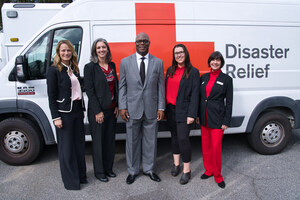INDIANAPOLIS, April 22, 2014 /PRNewswire-USNewswire/ -- The American Red Cross has undergone a transformation of its operations over the past six years to better deliver its humanitarian mission, improve efficiency and continue to make the best use of donor dollars, Red Cross President and CEO Gail McGovern told the Economic Club of Indiana today.
McGovern, who joined the Red Cross in June 2008, has led the organization's response to major disasters such as the Haiti earthquake, Superstorm Sandy and the Oklahoma tornadoes. The Red Cross had a $209 million operating deficit when she arrived, and the operating deficit was eliminated within two years by streamlining operations, eliminating duplication of some activities, and making tough decisions in the face of economic challenges.
As a result of these changes, the Red Cross has broken even or finished with a modest surplus in four of the past five fiscal years, and is paying down its debt.
"I couldn't be more proud of all our dedicated Red Crossers, from our donors to our volunteers and employees – who helped make this financial turnaround a reality," McGovern said. "I'm not exaggerating when I say that their hard work, sense of teamwork and commitment to our mission literally saved the Red Cross."
McGovern said the Red Cross is committed to being a healthy, vibrant and sustainable organization now and in the years ahead.
"I'm very proud of the transformations that we've undergone since 2008, but all of us at the Red Cross understand that we haven't been an outstanding humanitarian organization for almost 133 years by standing still or looking back," McGovern said.
The Red Cross is focused on a long-term plan that will continue to lower costs, put an even greater focus on engaging volunteers and allow the Red Cross to become even more efficient in delivering all of its programs.
"My time here has shown me that the Red Cross must always be planning for the future," McGovern said. "We have to continually find new and better ways to deliver our mission. We owe it to our donors to be the very best stewards of their generous contributions. Our goal is to be the non-profit of the future: a strong, stable organization that the nation can rely on for generations to come."
McGovern said an overall drop in demand for blood products poses a new set of financial challenges for the Red Cross. The decline in demand, caused by more advanced medical treatments and improved blood management by hospitals, impacts the entire blood services industry.
"In response to these changing market conditions, the Red Cross has embarked on a process to help right-size and restructure our blood operations," she said.
She said the Red Cross is relooking at its blood operations to adjust capacity to the new level of demand, improve services to all customers, streamline processes and increase productivity.
McGovern also described the past busy year for the Red Cross because of the large number of big disasters, noting that just a bit more than a year ago, the Red Cross responded to the terrible tragedy that occurred at the Boston Marathon and the explosion of a fertilizer plant a few days later in the small town of West, Texas. Then in May, devastating tornadoes hit Oklahoma and Texas, following by wildfires in many areas of the West. Meanwhile, the Red Cross continues to help people affected by Superstorm Sandy nearly 18 months after that storm hammered New York and New Jersey. Internationally, the Red Cross is playing an active role in the ongoing relief and recovery work in the Philippines in the wake of Typhoon Haiyan last November, and continues its work in Haiti after the 2010 earthquake there.
McGovern noted that these large disasters are only part of the nearly 70,000 disasters that the Red Cross responds to each year, a number that includes tens of thousands of single family house fires, local floods, and water main breaks, that never make it on the evening news or the local newspaper.
But she noted that responding to these disasters is also critically important to the Red Cross and the people affected.
"These seemingly 'small' disasters are of epic proportions for families that are impacted by one," McGovern said, "and the Red Cross must be there to provide food, shelter, and care."
The Red Cross also provides lifesaving training to millions of people each year, has issued a series of free apps on First Aid and different disasters, responds to international disasters, supports work such as measles vaccinations in countries around the world, and helps members of the military and their families before, during and after deployments.
About the American Red Cross:
The American Red Cross shelters, feeds and provides emotional support to victims of disasters; supplies about 40 percent of the nation's blood; teaches skills that save lives; provides international humanitarian aid; and supports military members and their families. The Red Cross is a not-for-profit organization that depends on volunteers and the generosity of the American public to perform its mission. For more information, please visit redcross.org or visit us on Twitter at @RedCross.
Logo - http://photos.prnewswire.com/prnh/20090108/RedCrossLOGO
SOURCE American Red Cross
WANT YOUR COMPANY'S NEWS FEATURED ON PRNEWSWIRE.COM?
Newsrooms &
Influencers
Digital Media
Outlets
Journalists
Opted In





Share this article